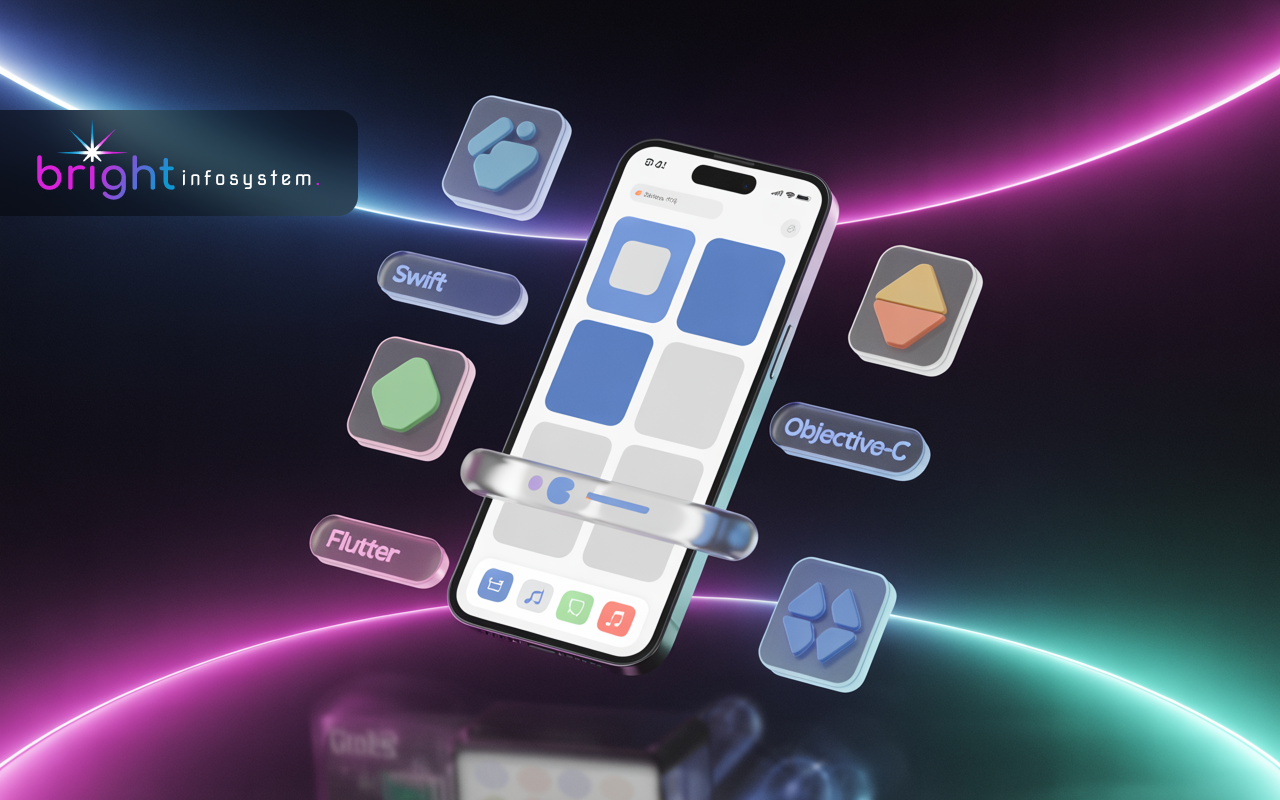Top Programming Languages for iOS App Development

Top Programming Languages for iOS App Development in 2025
In the fast-paced world of mobile technology, iOS app development continues to set the benchmark for innovation, performance, and user experience in 2025. As Apple pushes the boundaries with its ever-evolving ecosystem—spanning iPhones, iPads, Apple Watch, and Apple Vision Pro—businesses are under pressure to deliver apps that are not only functional but also cutting-edge. At the core of this process lies a pivotal decision: selecting the right programming language. This choice shapes your app’s performance, scalability, and ability to align with Apple’s dynamic ecosystem.
The programming landscape has transformed significantly. Objective-C, once the backbone of iOS development, has been largely replaced by Swift, Apple’s modern powerhouse. Meanwhile, cross-platform frameworks like Flutter and React Native have gained traction, offering cost-effective and efficient solutions for businesses targeting both iOS and Android. This evolution challenges iOS app development companies to adapt their tools, strategies, and approaches to deliver apps that meet modern expectations.
At Bright Infosystem, a leading provider of app development and web development services, we understand that choosing the right programming language is the foundation of a successful iOS app. Whether you’re a startup launching an MVP or an enterprise building a robust platform, our team at Bright Infosystem ensures your app is built with precision and future-ready innovation. Contact us at info@brightinfosystem.com to bring your vision to life.
Why the Choice of Programming Language Matters
Selecting a programming language for iOS app development is a strategic decision that impacts everything from performance to long-term maintenance. It’s not just about writing code—it’s about building an app that delivers a seamless user experience, scales with your business, and stays relevant in Apple’s fast-evolving ecosystem. Here’s why this choice is more critical than ever in 2025.
1. Performance and Scalability
A high-performing iOS app demands a language optimized for speed and efficiency. Native languages like Swift are designed to leverage Apple’s hardware and software, ensuring smooth performance. Meanwhile, cross-platform options like Flutter (Dart) and React Native (JavaScript) allow code reuse across iOS and Android, reducing development time and costs.
Key considerations:
- Speed and responsiveness: Native languages deliver fluid user experiences.
- Scalability: The right language supports growth without compromising performance.
- Cost efficiency: Cross-platform tools streamline budgets and timelines.
At Bright Infosystem, we analyze your project requirements to recommend the best language, balancing performance with cost-effectiveness.
2. Future-Proofing Your App
Apple’s ecosystem evolves rapidly, with new iOS versions, devices, and frameworks introduced regularly. A modern language like Swift stays in sync with Apple’s updates, while older languages like Objective-C may require costly migrations. Choosing a future-ready language ensures your app remains competitive and adaptable.
3. Developer Availability and Maintenance
Apps need continuous updates, bug fixes, and feature enhancements. Languages with active developer communities—like Swift, Dart, or JavaScript—offer access to a large talent pool, making it easier to maintain and scale your app. Bright Infosystem provides dedicated iOS developers to ensure long-term success, reachable at info@brightinfosystem.com.
4. Ecosystem and Community Support
Languages backed by Apple (Swift) or industry giants like Google (Dart) come with robust tools, libraries, and community resources. For example, Swift integrates seamlessly with Xcode and SwiftUI, enabling developers to create innovative user interfaces efficiently.
Partner with Bright Infosystem to leverage the right language for your app’s success. Visit brightinfosystem.com to learn more.
Top Programming Languages for iOS App Development in 2025
The iOS development landscape in 2025 offers a diverse range of programming languages, each with unique strengths. From native performance to cross-platform efficiency, here are the top languages shaping iOS apps, trusted by Bright Infosystem for delivering exceptional results.
1. Swift – Apple’s Modern Powerhouse
Swift is the go-to language for iOS development, powering apps across Apple’s ecosystem. Its speed, safety, and integration with tools like SwiftUI make it the preferred choice for native apps.
Why choose Swift?
- High performance: Optimized for Apple’s hardware, ensuring fast and fluid apps.
- Safety: Strong typing reduces errors and enhances reliability.
- Future-ready: Supports Apple’s latest frameworks like SwiftUI.
Use cases: Fintech apps, healthcare platforms, and e-commerce apps with rich UI.
2. Objective-C – The Legacy Option
While Swift has taken over, Objective-C remains relevant for maintaining legacy apps and hybrid codebases.
Why it’s still used:
- Legacy support: Essential for older enterprise apps.
- Interoperability: Works seamlessly with Swift.
- Stability: Proven reliability over decades.
Use cases: Upgrading legacy systems or supporting existing Objective-C codebases.
3. Dart (Flutter) – Cross-Platform Excellence
Flutter, powered by Dart, is a favorite for cross-platform development, allowing a single codebase for iOS and Android.
Why Flutter stands out:
- Hot reload: Speeds up development with real-time previews.
- Native-like performance: Delivers smooth, high-quality apps.
- Consistent UI: Ensures uniform designs across platforms.
Use cases: Startup MVPs, social apps, and retail platforms.
4. JavaScript (React Native) – The Hybrid Leader
React Native, backed by JavaScript, powers hybrid apps with a vast community and reusable components.
Why choose React Native:
- Code reusability: Build for iOS and Android with one codebase.
- Rapid deployment: Ideal for quick market entry.
- Community support: Access to extensive plugins and tools.
Use cases: Content-driven apps, event platforms, and internal tools.
5. Kotlin Multiplatform – Shared Logic, Native Experience
Kotlin Multiplatform enables shared business logic while maintaining native UI, making it ideal for complex apps.
Why it’s gaining traction:
- Code sharing: Reduces development effort without sacrificing UI quality.
- Modern syntax: Clean and efficient for developers.
- Enterprise support: Backed by JetBrains for robust solutions.
Use cases: Financial apps, B2B platforms, and logistics dashboards.
6. C# (Xamarin/.NET MAUI) – Microsoft Ecosystem Integration
C# with .NET MAUI is perfect for businesses in the Microsoft ecosystem, supporting iOS, Android, and more with a single codebase.
Why it works:
- Unified development: Streamlines UI and logic.
- Enterprise focus: Seamless integration with Microsoft systems.
- Reliability: Backed by Microsoft’s long-term support.
Use cases: Enterprise productivity tools and CRM extensions.
How to Choose the Right Programming Language
Selecting the best language for your iOS app involves aligning your business goals, app type, and resources. Here’s how Bright Infosystem guides you through the process.
1. Align with Your App’s Purpose
- Native apps (e.g., banking, healthcare): Swift for top performance.
- Hybrid apps (e.g., retail, events): Flutter or React Native for cost efficiency.
- Enterprise apps: C# or Kotlin Multiplatform for backend integration.
- MVPs: Flutter for rapid prototyping.
2. Evaluate Team Size and Budget
- Small teams: Opt for Flutter or React Native for faster development.
- Large teams: Leverage Swift or Kotlin for complex architectures.
- Tight budgets: Cross-platform tools reduce costs.
3. Plan for Long-Term Success
Choose languages with strong community support and Apple alignment, like Swift or Flutter, to ensure scalability and ease of maintenance.
4. Partner with Experts
At Bright Infosystem, we’ve delivered hundreds of iOS apps across industries—fintech, healthcare, e-commerce, and more. Our expertise ensures your app is built with the right technology for lasting success. Contact us at info@brightinfosystem.com.
Top iOS Development Tools in 2025
Beyond languages, the right tools are critical for building exceptional iOS apps. Here’s what Bright Infosystem uses to deliver high-quality solutions.
1. Xcode – Apple’s Official IDE
Xcode remains the cornerstone for Swift and Objective-C development.
- Seamless integration with Apple SDKs
- Real-time debugging and testing
- Support for SwiftUI and Storyboards
2. SwiftUI – Next-Gen UI Framework
SwiftUI simplifies UI development across Apple devices.
- Multi-platform deployment
- Reduced coding effort
- Dynamic animations and previews
3. Flutter & React Native – Cross-Platform Powerhouses
- Flutter: Dart-based, customizable UI.
- React Native: JavaScript-driven, rapid deployment.
4. Essential Libraries
- Firebase: Real-time data and analytics.
- Alamofire: Simplified API integration.
- Realm: Efficient local storage.
- Lottie: Seamless animations.
- Sentry: Error tracking and monitoring.
Bright Infosystem combines these tools with Swift, SwiftUI, and cross-platform frameworks to deliver apps that excel in performance and scalability.
Why Choose Bright Infosystem for iOS App Development?
Building an iOS app in 2025 requires more than code—it demands a partner who understands your business. Bright Infosystem, with its expertise in app and web development, is your trusted partner.
1. Comprehensive Expertise
Our developers are proficient in Swift, Flutter, React Native, and more, ensuring tailored solutions for every project.
2. Proven Track Record
With over 1200 apps delivered and a 95% client retention rate, we deliver results across industries like fintech, healthcare, and e-commerce.
3. Streamlined Development Process
- Consultation: Aligning with your vision.
- Design: Apple-compliant, user-centric UI/UX.
- Development: Leveraging top tools like Xcode.
- Testing: Rigorous validation on real devices.
- Support: Continuous optimization post-launch.
4. Dedicated Development Teams
Our flexible, scalable teams offer full-time, part-time, or hourly engagement, treating your project with utmost care.
Ready to build a world-class iOS app? Contact Bright Infosystem at info@brightinfosystem.com or visit brightinfosystem.com.
Conclusion
In 2025, iOS app development is a dynamic field where the right programming language can define your app’s success. From Swift’s native excellence to Flutter’s cross-platform efficiency, each language offers distinct advantages. However, the key to success lies in partnering with a team that brings expertise, innovation, and a client-focused approach.
At Bright Infosystem, we deliver iOS apps that are fast, scalable, and built to thrive in Apple’s ecosystem. Whether you’re launching a fintech solution, an e-commerce platform, or a healthcare app, our dedicated developers are here to make your vision a reality. Reach out to us at info@brightinfosystem.com or explore our services at brightinfosystem.com.
Let’s build the future of iOS apps—together.



